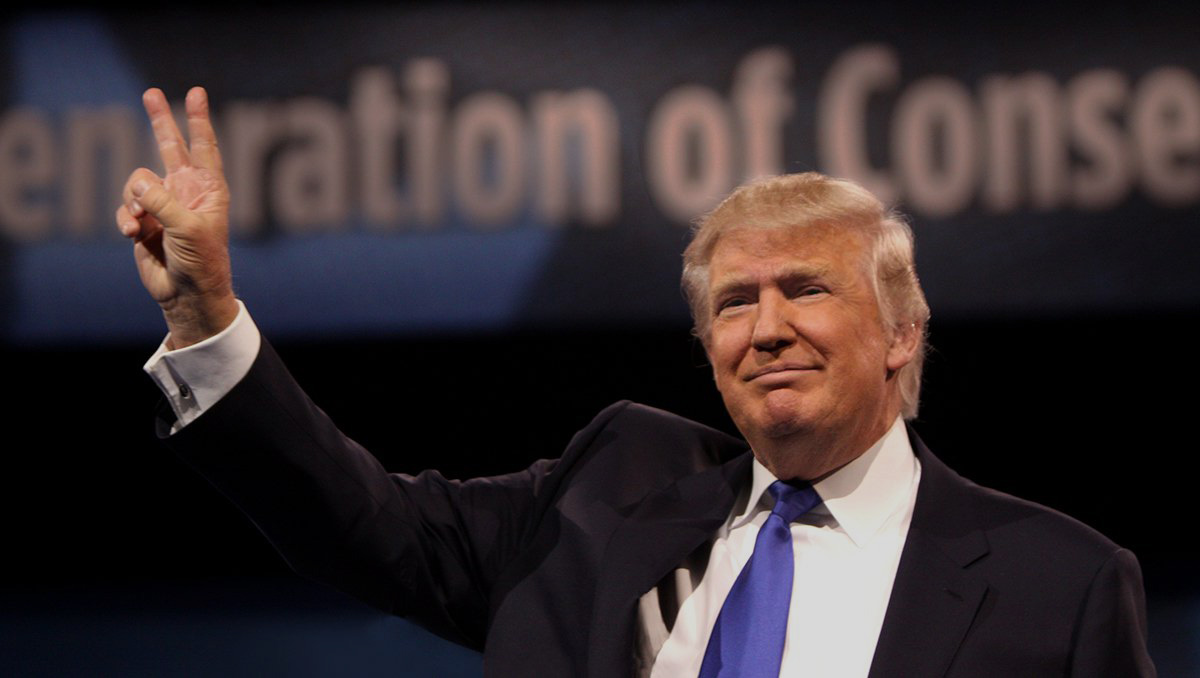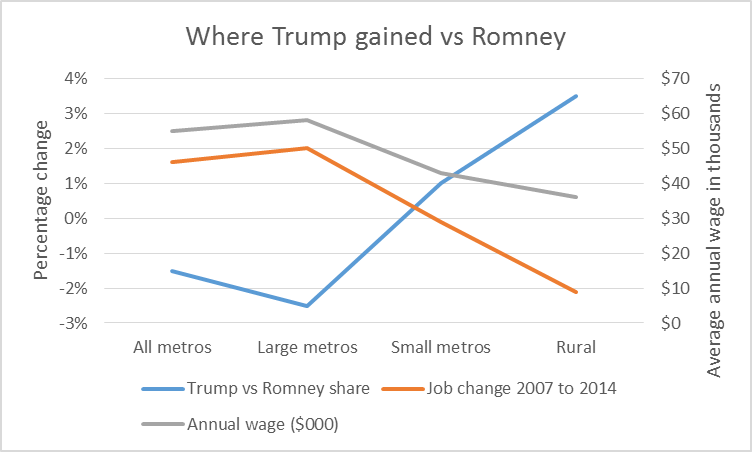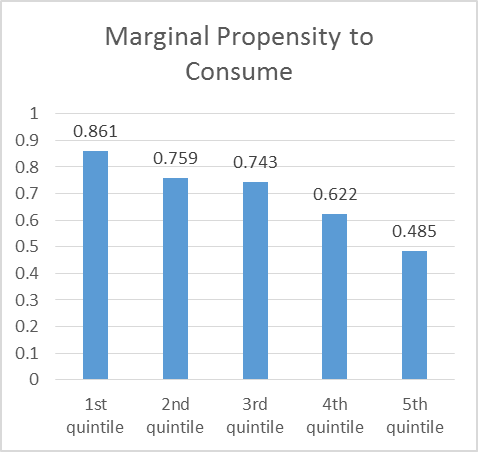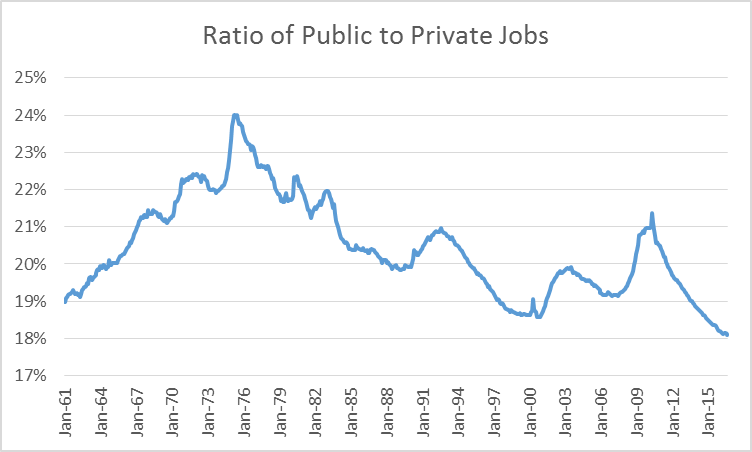Can Trump Voters’ Pessimism Be Overcome?
Identity politics failed. Democrats need policies that help all, regardless of race, region.
An earlier Data Wonk article pointed to the deep pessimism of Trump voters, especially compared to Clinton voters. A strong majority of Trump supporters agreed that life had gotten worse for people like them in the last 50 years and that things would continue to deteriorate in the future.
In the recent election, Donald Trump succeeded in turning several traditionally Democratic regions, notably a plurality of Wisconsin voters, red by promising to turn around the economic fortunes of regions and workers who’ve lost out because of shifts in the economy. A post-election analysis by Richard Shearer of the Brookings Institution suggests this loss of Democratic votes is underpinned by economic distress.
Shearer looks at the growing urban-rural divide both in voting patterns and economic performance. The chart below shows his results for all metropolitan areas, large metros, small metros, and rural areas. (He also subdivided the results for large metros, including primary cities, inner and outer suburbs, and exurbs). As the blue line in the graph shows, Trump lost votes compared to Romney in metropolitan areas as a whole, and particularly in large metros. However, he outperformed Romney in small metros (those with fewer than 500,000 people) and did especially well in rural areas.
As the chart also shows, Trump’s gains reflect areas that are suffering economically. The number of jobs has still not returned to the pre-recession peak in the areas where Trump gained (orange line). The average wage is also far lower in the Trump-supporting areas (gray line and right axis).
The term that is commonly used to refer to the voters switching to Trump is “white working class.” This term, while technically accurate, is unfortunate in my view. It racializes the issue, obscuring the more important driving force behind the switch of voters from Barack Obama to Trump. They are responding to real problems: the loss of jobs leading to the depopulating of rural areas and the resulting growth of a variety of social problems.
Racializing problems also feeds one of the least attractive tendencies on the left: thinking of the population in terms of ethnic groups rather than individuals. This makes it harder to work for a race-blind society. From a practical viewpoint, it also makes it harder to sell reforms if they are regarded as favoring a particular group. Identity politics probably cost Clinton the election by turning off voters living in the areas hard hit by economic change. Only Trump was seen as taking their concerns seriously, rather than dismissing them as the product of white racism.
Trump’s victory has set off squabbles among Democrats. Should more be done to reach out to working class whites? Or should more be done to convince the emerging Democratic base to turn out? In my view this is the wrong choice, both morally and politically. Instead, policies should be developed to help everyone who is left behind by economic changes.
It is worth noting that the areas which put Trump over the top are largely victims of the free market in action. Both manufacturing and agriculture over the years have had huge increases in productivity. Generally productivity increases are considered a good thing—the prerequisite for increased prosperity. However productivity is defined as the ratio of outputs to inputs, for instance the number of washing machines produced to the labor used to make them.
The recent decline in coal mining jobs, another area where Trump has promised to reverse history, is indeed partly the result of concern over climate change. However, this is only part of the story. The long-term decline in coal mining jobs started long ago, originally driven by increases in mining productivity. More recently, new technology has lowered the costs of coal’s competitors, whether natural gas from fracking, or solar or wind energy. Growing concern over pollution, particularly in China, coal’s largest market has also cut the demand for coal.
So far, Trump has given no indication that he knows how to help the people who live in regions hurt by changes in the economy. Several of his promises would make their situation worse, but it is unclear which he was serious about and which were aimed at winning.
For instance Trump promised to repeal Obamacare and replace it with “something terrific,” but it appears that he gave no thought to what the replacement could be. Simply repealing Obamacare would mean that those who gained insurance due to Obamacare would lose it.
After meeting with President Obama, Trump declared that he liked the Obamacare prohibition against denying people coverage because of their pre-existing conditions. But eliminating provisions aimed at pushing healthy people into the market, like the individual mandate, could easily push the individual health insurance market into the well-known “death spiral.” Knowing they are guaranteed coverage, some healthy people would wait until they get sick to buy insurance, driving up premiums. As a result, even for healthy people, individual insurance could be very expensive or unavailable.
A second example is Trump’s proposal for a drastic tax decrease mainly directed at the very wealthy, such as himself. Much of Trump’s appeal was based on resentment of elites. Certainly very wealthy people count among the elites, and they have managed to get a steadily increasing share of the benefits of a growing economy. Government policy aimed at accelerating this trend is hard to justify.
An argument is made that low marginal rates for the wealthy are the secret to prosperity, but the evidence is not there. If the goal is to stimulate the economy, then aiming a tax decrease at low-income people is likely to be more effective. For example, Moody’s Analytics calculated the marginal propensity to consume of people at different income levels. Those in the bottom were estimated to spend 86 percent of any tax savings while those at the top would spend less than half.
During the time that Bill Clinton was president there was a bipartisan attempt to end welfare. In order to receive aid, people were required to show they were actively job-hunting or getting training. This reform worked remarkably well so long as the private job market was strong.
Missing, however, was any commitment on the part of the government to step in if the private sector fell short. Instead of making a commitment of a job, many of the social programs were aimed at addressing the problems caused by chronic joblessness, whether in coal mining country, the cities whose plants have closed, or the low-income parts of cities like Milwaukee.
During the Depression, federal job programs resulted in a series of improvements, new trails, park buildings, etc. that continue to benefit us today. (I particularly like the Grant Park pavilion.) There are a number of needs today, such as replacing lead water lines, which are not addressed because there is no money.
In many ways this approach would be a return to the philosophy of the New Deal, with its emphasis on work rather than welfare. Senators Tammy Baldwin and Cory Booker have introduced a bill, called the “Stronger Way Plan,” incorporating some of these ideas, in particular a transitional jobs program subsidizing jobs for unemployed people.
In a less polarized time, this plan would appeal to pragmatic Republicans. After all, things like the earned income tax credit were largely a Republican invention. It makes no sense to insist that unemployed people get jobs if there are no jobs.
However at a time when winning elections and ideology trump all other considerations, the plan runs up against several myths. One is the myth of the steadily expanding government. In reality the government has shrunk. As the next chart shows the portion of government employment, at all levels has been on a downward trend since the recession in 1975. It is lower today than at the end of the Reagan administration.
Rather than arguing about whether the white working class is worth wooing, Democrats should concentrate on assuring that there are jobs for everyone, wherever they live, whatever ethnic group they belong to, and whoever they vote for.
Data Wonk
-
Why Absentee Ballot Drop Boxes Are Now Legal
 Jul 17th, 2024 by Bruce Thompson
Jul 17th, 2024 by Bruce Thompson
-
The Imperial Legislature Is Shot Down
 Jul 10th, 2024 by Bruce Thompson
Jul 10th, 2024 by Bruce Thompson
-
Counting the Lies By Trump
 Jul 3rd, 2024 by Bruce Thompson
Jul 3rd, 2024 by Bruce Thompson

























First, the current popular vote count is that Clinton got about 2.5M more votes than Trump–just not in the right places for electoral-college math.
Indeed many people are hurting and Trump appealed to that pain with some emotional statements–and few actual plans. He has already ditched or majorly shifted most of his promises and it’s only two weeks in.
Dems need to do a better job of pitching their policies and candidates. However, one big challenge is that once people decide they like a candidate emotionally it’s often impossible to change their minds, no matter what facts are presented. That proved true with Trump, including statements by him Perhaps the truest statement Trump made was that he could shoot people in the middle of 5th Avenue and his supporters would stick with him.
David Brooks has said Trump will also probably break the heart of anyone who trusts in him–starting with Paul Ryan. Will be interesting to see what happens then.
Good article, Mr. Wonk. Trump did make a lot of promises to rural America and my best guess is he probably will disappoint. Obama won Wisconsin in 2008 by 12 or 13 points which is impressive but in the end he too in the eyes of the Wisconsin voter disappointed. In the end it is very hard to carry the same political party to a third term. Change is on the ticket. My understanding from an article on JS Online last week that last minute voters went to Trump at a 70 to 30 ratio versus Clinton and in the end it was change that made this state red. Trumps own polling agency did not even think Wisconsin would go red. Your article presented well the idea of productivity in the job market and how it leads to diminished jobs orfor example, the abundance of natural gas killing coal jobs. Trump has a problem here. I only see one silver lining for Trump. Every day ten thousand baby boomers retire and this could lead to better employment outlooks for job hunters.
Going to read the article in full. First thoughts though: “pessimism” is the wrong word. “Principles” is better.
If trump really cared about unifying the country he would have appointed anyone else in the world to his cabinet positions.
So that argument’s dead.
If you think I’m going to “compromise” on my principles of civil rights – if you think any of is will – you don’t understand me – you don’t understand this country.
There are many factors that account for the election results. But it is important to consider policy decisions made at the state level that were intentionally missed opportunities to help the voters who went for Trump this time. I am no apologist for the DNC or Hillary Clinton. But in 2008 voters wanted improvements in their ability to access health insurance, and Mitch McConnell announced from the very beginning that his party would do all it could to obstruct these improvements. Gov. Walker, aided and abetted by conservative talk radio, turned down federal money for the train and the ACA, which could have helped with economic development and assisted more lower income voters with their insurance costs. The Republican party continues to insist that government’s best role is privatizing and deregulating, but we have much evidence that the results don’t trickle down to those most in need. The party’s genius is in successfully blaming the Obama administration for these failures. Many pessimistic, frightened Trump voters believe Trump has heard them and that he will direct the government to do something for them. In other words, these voters are placing their faith in the party that does not actually believe it government’s role to help people like them. It is hard to see how this can work out well for us, but it seems certain that the deep divisions the Republican party has sown in its efforts to discredit Democratic principles and, more specifically, the Obama administration, will not be easily mended.
And actually analysis by FiveThrityEight show that it wasn’t income but education. It wasn’t “white working class” that pushed up Trumps margins, but poorly educated people:
http://fivethirtyeight.com/features/education-not-income-predicted-who-would-vote-for-trump/